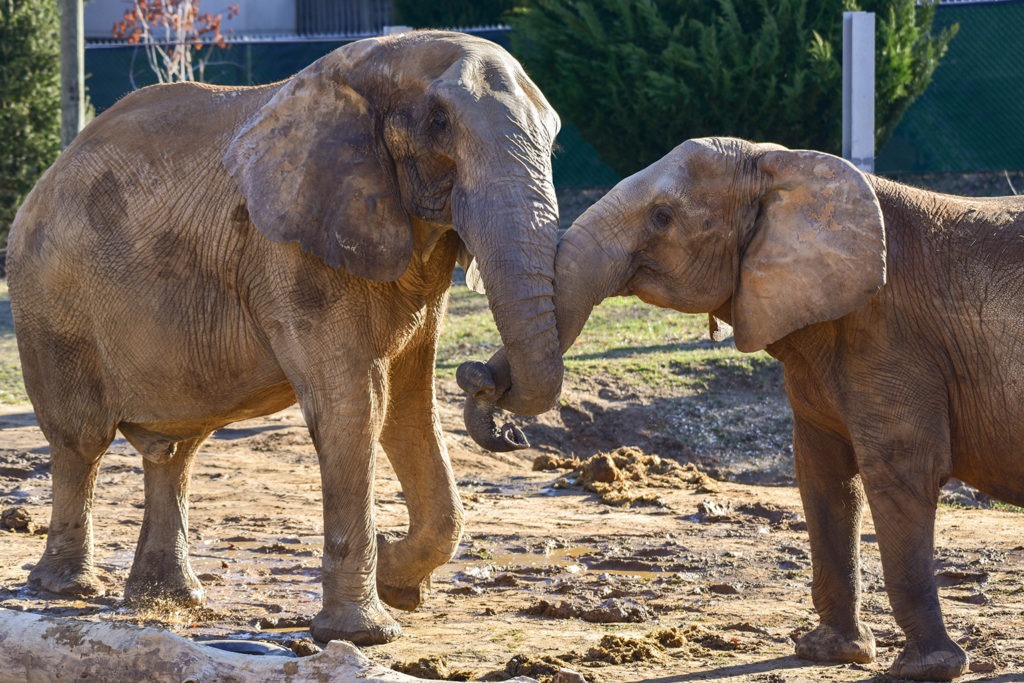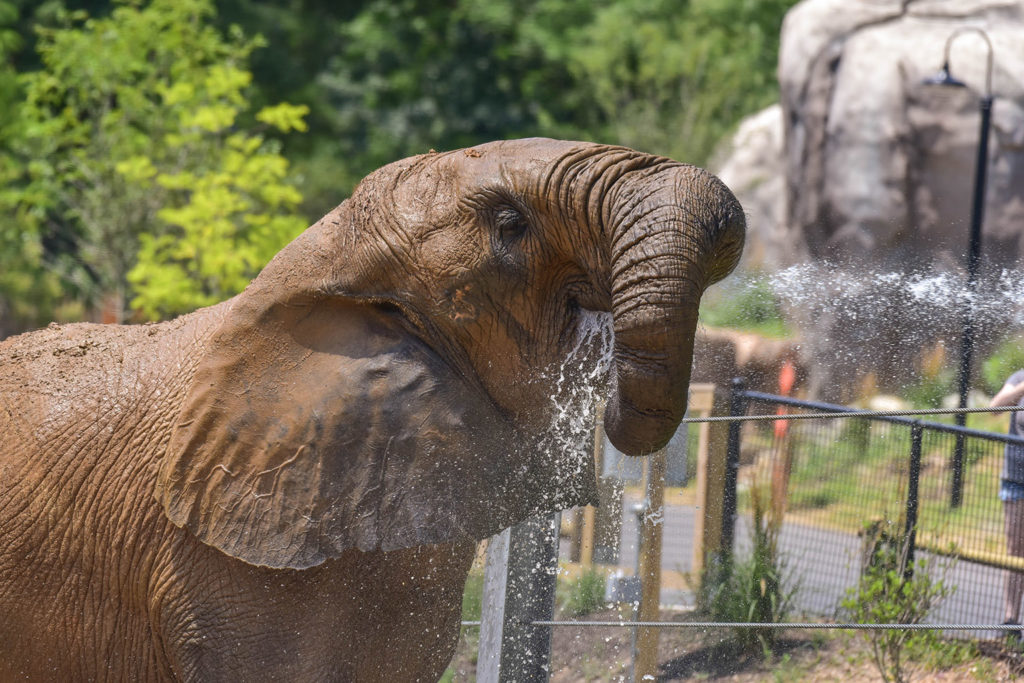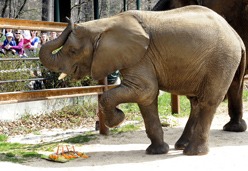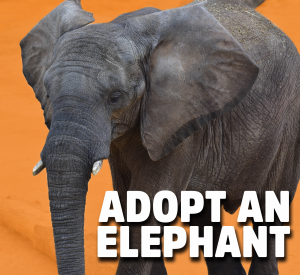Overview
“Where I live”
There are two subspecies of African elephant: the savanna elephant (Loxodonta africana) and the forest elephant (Loxodonta cyclotis). The savanna elephant is found in eastern and southern Africa, living in varied habitats including marsh, savanna, woodlands, and semi-desert.
All of the elephants at the Maryland Zoo are African elephants of the savanna type. You can see the elephants on exhibit in the Zoo’s African Journey area.
“How I Live There”
Elephants are family-oriented animals with complex social lives. Related females live together for life in herds and raise offspring together. All members of a herd defer to one leader, the oldest and wisest female in the family group, known as the matriarch. She leads the others to water and food, decides when to sleep and when to move, responds first to threats, and basically takes charge in every conceivable situation.
As male elephants reach adolescence, they strike out on a different path from their female relatives. They leave their birth herds. Young males often seek out other males their age and form close bonds. Younger males also may associate with older males in loose groups known as bachelor herds. While the social lives of both male and female elephants remain mysterious in many ways, and while there are still many questions to be answered, it appears that male elephants learn and practice how to “be male” while in the company of other males in bachelor herds.
Adult male elephants also are inclined instinctively to spend much of their time alone. This is especially true when a male elephant enters musth, a period of heightened aggression that paves the way for asserting dominance and competing successfully for females. All male elephants are in constant search of mates, but only those that assert their dominance over other males will win the right to breed.
Elephants require a tremendous amount of food to maintain their massive bodies. In a single day, one elephant may eat 300 pounds of vegetation, including grasses, roots, bark, leaves, and fruit, and drink 30 to 50 gallons of water. In order to find this much food and water, wild elephants are almost always on the move.
Elephants can communicate with each other over long distances through sound, including low-frequency infrasound that humans can’t hear. Standing up close to an elephant making an infrasonic call, you might hear or feel a low rumble. Another elephant would be able to hear that infrasonic call up to 12 miles away! Elephants also communicate through touch, sight, smell, and chemical processing. Body language is highly developed in elephants. Their sense of smell is as exceptional as their sense of hearing, and they also exhibit long-term memory. They are extremely social animals that protect their weakest, help their injured, and seem to mourn their dead.
“Making My Mark”
Elephants affect their environment perhaps more than any other creature on earth. Their size, strength, and food needs make this inevitable. They can completely change a landscape just by feeding. They strip bark and leaves from trees and bushes, pull trees straight out of the ground, trample underbrush, dig for roots, dig holes in dry riverbeds to reach water, and spread plant seeds over many miles with dung deposits. There can be no mistaking when an elephant herd has passed through an area. Because of their tremendous environmental impact, elephants also greatly influence the survival and adaptive strategies of many other plant and animal species sharing the same ecosystem.
“What Eats Me”
Given their tremendous size and strength, and because they gather in groups, elephants have few predators to worry about. Lions, hyenas, and crocodiles may attempt to prey on young or sick elephants. However, elephants are often successful at fending off predators, protecting their young, and defending sick or injured herd mates. For example, when a matriarch detects a nearby predator, she will herd offspring together and all other adult females in the group will form an outward facing circle around them, providing many layers of protection from the would-be attacker. Elephants are most vulnerable to, and threatened by, humans. Demand for elephant tusks – the main source of commercial ivory – has led to aggressive poaching that has decimated elephant populations across Africa. Elephants may also fall victim to farmers defending their crops or local residents fearful of interactions with elephants. Although it is illegal to kill wild African elephants, it has proven extremely difficult to eradicate poaching and other elephant killings.
Raising Young
Female elephants reach sexual maturity at about age 10 but may not mate for several more years. When females come into estrus, they attract breeding bulls. Bulls of the highest rank will gain access to females and breed. After an exceptionally long pregnancy of about 22 months, a female will give birth to usually one calf, and very rarely to twins. She will nurse her offspring for about 4 years, usually until she gives birth again, but she will care for each offspring for many years more. Baby and juvenile elephants in a herd have the benefit of multiple caregivers, as all female relatives share in raising the young. In particular, young females take on the role of allomother, which is comparable to a babysitter. They keep watch over the youngest elephants, help them, comfort them, play with them, and gain mothering experience all the while. Research has shown that elephant family groups with few or no allomothers suffer higher infant mortality than those with allomothers.
Conservation
African elephants are listed as endangered by the IUCN, the world’s leading conservation organization. Conservation issues affecting African elephants are complicated. Despite an international ban on ivory trade passed in 1989, poaching remains a significant threat. Competition with humans for limited space and resources is an equally significant threat. African elephants once ranged freely from south of the Sahara Desert to northern South Africa. Today, they are mostly confined to parks and reserves. As a result, their natural habitats are fragmented and there can end up being too many elephants in too little space, yet those that range outside of protected borders are quite likely to come into conflict with people or to be killed by poachers. In order to insure that African elephants continue to walk the earth for many generations to come, successful long-term resolution to human-elephant competition and conflict must be achieved.
Taxonomy
- Kingdom: Animalia
- Phylum: Chordata
- Subphylum: Vertebrata
- Class: Mammalia
- Order: Proboscidea
- Family: Elephantidae
- Genera: Loxodonta
- Species: africana
Skin
Elephants–along with rhinos and hippos–are known as pachyderms. The name comes from the Latin words for “thick” (“pachy”) and “skin” (“derm”) and means, quite literally, “thick-skin.” Yet although the skin is almost one to two inches thick in some areas, it is less than one millimeter thick in others. One such area is behind the ears where large amounts of blood vessels are found close to the skin surface. Warm blood passing through these blood vessels is cooled before recirculating throughout the body. The skin also helps to disperse an elephant’s body heat, cooling the animal. (Elephants lack sweat glands.)

Elephants have evolved many folds in their skin layers, giving them their “baggy” and wrinkled appearance. The folds serve an important purpose by increasing the overall surface area of the skin, which provides more space to allow for the dispersion of body heat. The wrinkles also are the main reason elephants will mud bathe. The initial cooling of the wet mud helps the elephant cool down instantly. Moisture trapped in all of the wrinkles continues to cool the elephant even after it leaves the mud source. The mud also protects the elephant’s skin from insects, sun, and moisture loss.
Food
Elephants are herbivores, which means that they only eat plant material. African elephants eat a huge variety of plant material including grasses, bark, twigs, roots, leaves, fruits, and vegetables. They are even capable of eating the wooden trunks of trees and logs by chipping off pieces with their tusks or by simply chewing on them with their huge grinding teeth.

Elephants maintain their large size by ingesting an enormous amount of food. Elephants have highly inefficient digestive systems; nearly 60% of the food they eat goes undigested. The trunk, tusks, and teeth are highly adapted to help them acquire and process the large amounts of food they need.
Trunk
The trunk is a modification of the upper lip and the nose combined. At the end of the trunk are two fingerlike projections that are used to pinch and grip both small and large food items and objects. The trunk is composed of more than 100,000 bundles of muscle fibers, which make it a very strong and agile appendage. There is no other appendage in the entire animal world known to be as specialized as an elephant’s trunk.

An elephant uses its trunk to suck up water and blow the water into its mouth or onto its body for bathing and cooling purposes. However, an elephant cannot drink water through its trunk.
In addition to food gathering, drinking, and bathing, the trunk is used for social interactions among herd mates. Elephants make regular contact with one another using their trunks. Such social interactions may include greeting, caressing, and demonstrations of dominance or submission through subtle positioning of the trunk and different trunk postures. The trunk can also act as a resonating tube, producing the classic sounds of an elephant trumpet or the sounds of a subtle, reverberating communication rumble.
Perhaps one of the most interesting and yet lesser known facts about an elephant’s trunk is that it is able to detect and distinguish smells several hundred times better than any dog on the planet! Smell is one of an elephant’s greatest senses and it is all located in the trunk.
Tusks
An elephant’s tusks are modified teeth. They are an elongation of the second incisors and continue to grow throughout the life of the elephant. Tusks are used for digging, debarking trees, moving objects, making contact with one another, intimidation in dominance displays and for general tools in elephant life. Males use their tusks when sparring with each other and establishing dominance.
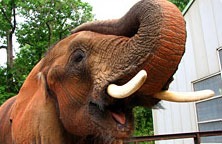
Tusks are made of ivory, which is an incredibly dense form of bone. It forms in a cross thatch pattern, making it very hard. There continues to be great demand for ivory tusks because of their unique properties and inherent beauty. Because they will fetch a high price, poachers continue to illegally kill elephants for their tusks. This is a major factor in the decline of wild elephant populations worldwide.
Teeth
An elephant has only four teeth in its mouth. They are considered molars and are found in each section of the jaw, two on each side of the mouth. One tooth can be the size of a brick and has a large surface area of ridges specifically adapted for grinding the large volume of plant material that elephants eat every day.

The teeth get worn down with all the grinding and chewing of fibrous plant material. To compensate, elephants have evolved replaceable teeth! An elephant has six sets of teeth in its lifetime. Replacement teeth come in horizontally rather than vertically like ours. The older tooth is pushed forward by the newer tooth and eventually falls out in pieces.
Communication
Elephants are considered one of the most intelligent of all land animals. They have the largest brains of any mammal. The temporal lobes of the elephant’s brain, which function in recognition, storage, and retrieval of information related to sight, touch, smell, and hearing, are especially large and enormously complex. Relative to brain size, these temporal lobes appear to be larger, more convoluted, and denser than those of all other animals except humans. Based on scientific evidence, elephants seem to remember individuals, places, and learned skills for years. It really is true that “an elephant never forgets.”
Elephants have a highly developed system of communication through sounds. Elephants produce a broad range of sounds from very low frequency, inaudible infrasound to soft rumbles, trumpets, snorts, roars, and even growls. The low frequency, or infrasound, allows elephants to communicate across miles. It is below the range of sound that the human ear can detect. Elephants detect the low vibrations through their ears, feet, and trunk tip. Special adaptations in each of these parts of the body pick up and transmit sounds to the hearing centers of the brain.
Elephants also possess one of the most well-developed senses of smell in the animal kingdom. This keen sense of smell is used not only to locate food and water sources but also for communication. Elephants detect and process many chemical signals in a wide variety of smells throughout their environment. Sources of odors used in chemical communication between elephants include urine, feces, saliva, and secretions from the temporal gland.
Elephants are family-oriented. Herds are made up of adult female groups and their offspring. Older, more experienced females lead elephant families. They are called dominant females or matriarchs of the herd. Each herd consists of mostly related females (mothers, aunts, grandmothers, and cousins) and their calves, including young male offspring and occasionally non-related individuals. Herd sizes range from 20 to 100 individuals. Female family members stay together for life.Young males entering adolescence leave their family groups to join bachelor herds, but at times lead a solitary life due to a natural condition called “musth”. Musth in adult bull elephants is characterized by a significant increase in reproductive hormones (specifically testosterone) that results in strong changes in behavior. Bachelor herds are important for teaching young males how to become strong, adult bulls. Adult bulls associate with female herds for breeding purposes only.
One of the most important functions of the female herd is to raise calves. A female usually has her first calf while in her teens. A male becomes reproductively mature on average at age 13 but usually won’t breed with females until his late 20s when he is large and strong enough to compete with other bulls for the opportunity.
Once a female is pregnant, gestation lasts about 22 months. She will give birth to a calf that weighs 150 to 300 pounds and stands two to three feet tall. At birth, a calf is almost helpless and does not have full use of its trunk yet, but will quickly get to its feet and stand on its own. The new calf begins nursing within a few hours of standing and quickly gains the strength and coordination needed to keep pace with its mother as she moves around in search of food. Elephants have a very long adolescence, with a developmental rate similar to humans, and a long life expectancy.
Social Structure
Elephants are family-oriented. Herds are made up of adult female groups and their offspring. Older, more experienced females lead elephant families. They are called dominant females or matriarchs of the herd. Each herd consists of mostly related females (mothers, aunts, grandmothers, and cousins) and their calves, including young male offspring and occasionally non-related individuals. Herd sizes range from 20 to 100 individuals. Female family members stay together for life.

Young males entering adolescence leave their family groups to join bachelor herds, but at times lead a solitary life due to a natural condition called “musth”. Musth in adult bull elephants is characterized by a significant increase in reproductive hormones (specifically testosterone) that results in strong changes in behavior. Bachelor herds are important for teaching young males how to become strong, adult bulls. Adult bulls associate with female herds for breeding purposes only.
One of the most important functions of the female herd is to raise calves. A female usually has her first calf while in her teens. A male becomes reproductively mature on average at age 13 but usually won’t breed with females until his late 20s when he is large and strong enough to compete with other bulls for the opportunity.
Once a female is pregnant, gestation lasts about 22 months. She will give birth to a calf that weighs 150 to 300 pounds and stands about 3 feet tall. At birth, a calf is almost helpless and does not have full use of its trunk yet, but will quickly get to its feet and stand on its own. The new calf begins nursing within a few hours of standing and quickly gains the strength and coordination needed to keep pace with its mother as she moves around in search of food. Elephants have a very long adolescence, with a developmental rate similar to humans, and a long life expectancy.
